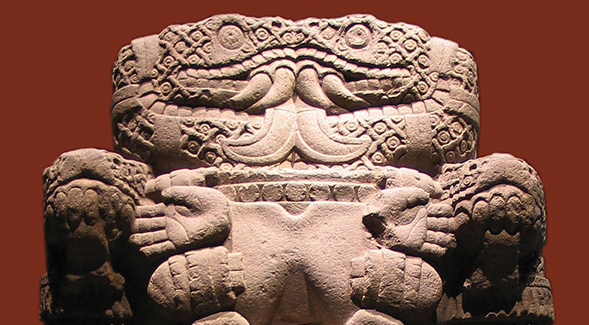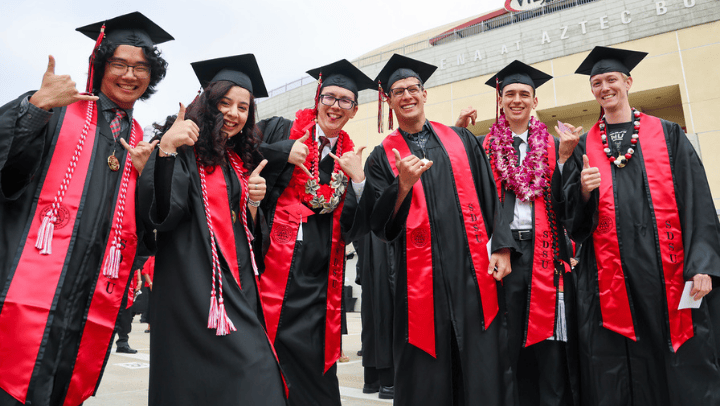Aztec for Life: What it Means Now
A new initiative to build respect for Aztec culture is taking root at SDSU this year.

This story appears in the summer 2018 issue of 360: The Magazine of San Diego State University.
One sure harbinger of the fall semester at San Diego State University is the buildup to Templo del Sol, an annual rite of passage for new students. This symbolic event takes its name from ceremonies associated with the Aztec Pyramid of the Sun.
Orchestrated by SDSU Alumni, Student Affairs and student leaders, Templo del Sol introduces new freshman and transfer students to campus traditions and marks their first official day as Aztecs.
This year’s new students will be better prepared than ever to honor the Aztec identity. From the moment they step foot on campus for orientation, they’ll begin to learn about the indigenous culture whose name SDSU has carried for decades.
Information provided throughout new student orientation to students and their parents includes historically based knowledge about the Aztec civilization, including its language, compulsory education system, calendars, engineering skills and literary prowess.
By the time these students graduate, their Aztec pride will be grounded in respect and knowledge of a mighty Mesoamerican culture.
Foundation of respect
Leading the education initiative is a group of students, faculty, staff and alumni known as the Aztec Culture Education Committee (ACEC). Former SDSU president Sally Roush reconvened the committee as part of her May 17 decision to retain both the Aztec name and the Aztec Warrior as SDSU’s spirit leader.
Roush’s decision followed three months of work by the ad hoc Aztec Identity Task Force. Their deliberations were informed by a deep dive into the history of Aztec culture and the results of a survey sent to more than 200,000 constituents, who advocated overwhelmingly for retaining the Aztec identity.
“One consistent, overarching message was conveyed in a loud and clear voice: Respect, genuinely intended and executed, must be the foundation of our actions going forward,” Roush said at a meeting of the University Senate, during which she shared the task force’s recommendations and her decisions.
It’s a commitment the ACEC takes to heart, said co-chairs Ramona Pérez and Christy Samarkos. Pérez is a professor of anthropology and director of SDSU’s Center for Latin American Studies (CLAS). Samarkos is an associate vice president for Student Affairs.
Educational moments
The 17-member committee is moving forward on two parallel paths. The first honors the Aztec legacy by giving students multiple avenues to learn about its history, culture and language. SDSU now offers instruction in Náhuatl, the language of the Aztecs that is the most spoken language in Mexico after Spanish, as well as instruction in the indigenous languages of Mixteco and Zapoteco.
The ACEC’s second path deliberately aims to include local indigenous people in SDSU’s significant events, such as commencement and convocation. Pérez and Samarkos noted that this is not intended to conflate the identities of local tribes with Aztecs, but rather to underscore SDSU’s commitment to inclusivity of the many indigenous people who impact the university.
“There will be many, many educational moments available in online education programs, podcasts, live lectures, arts events, and leadership skills training relevant to the Aztecs and the Náhua people,” Pérez said. “Incorporating Aztec history and Náhua culture into the academic curriculum will be the prerogative of individual faculty members.”
SDSU Athletics and SDSU Alumni are partners in educational efforts, and season ticket-holders will find “did you know” facts about the Aztec culture included with their tickets. For example, “Did you know that the combination of red and black in Aztec culture signified literacy and education?” and “Did you know that the three pillars of the Aztec Empire were knowledge, strength and prowess, and giving back to the community?”
Serious issue
Roush’s charge—to embrace the Aztec identity with respect—is a responsibility ACEC members take seriously, and none more so than the students. Committee member Michael Wiafe, who is also vice president of external relations for Associated Students (AS), believes the university is in a unique position at this moment to educate the SDSU community about Aztec culture.
"Associated Students understands the seriousness of this issue," he said. "As the decision has been made to retain the identity, there has to be respect and education."



